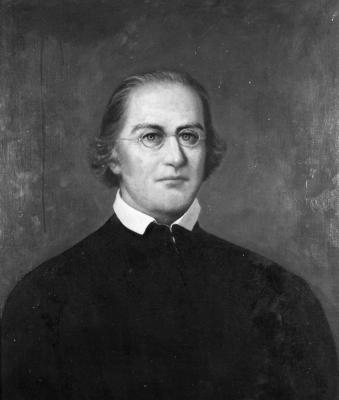President: 1817-1820
Fr. Anthony Kohlmann, S.J., served as Georgetown's 11th president from 1817-1820. Fr. Kohlmann had advocated for the university's closure before his appointment as president. His presidency featured declining enrollment and a foiled student plot to murder Fr. Stephen Dubuisson.
Early Jesuit and academic career
Anthony Kohlmann was born in France, but the French Revolution drove him to study in Switzerland. In 1796, Kohlmann joined the Fathers of the Sacred Heart, before entering the Society of Jesus and traveling to the novitiate in Russia. Fr. Kohlmann served first in Germany, then Holland and England before coming to the United States.1 In 1806, Fr. Kohlmann arrived at Georgetown where he taught philosophy to the Jesuit scholastics and seminarians.
In 1808, Archbishop John Carroll sent Fr. Kohlmann to New York along with four Jesuit scholastics and Fr. Benedict Fenwick. There Fr. Kohlmann established the New York Literary Institution (NYLI) with Carroll’s blessing. Originally intended as a preparatory school for Georgetown, Fr. Kohlmann began to champion the NYLI as Georgetown’s replacement, “Georgetown College should be transferred bodily to New York. It would be fifty times more for the advantage of the Society to have a college at N.Y. than in any other part of the union.”2Unfortunately, the Jesuits were unable to staff both Georgetown and the NYLI, and they closed the NYLI against the protests of Fr. Kohlmann after only five years.
In 1815, Fr. Kohlmann became master of novices at the White Marsh novitiate and then head of the Maryland Mission in 1817. Later that year, when Fr. Benedict Fenwick left for Rome, Fr. Kohlmann succeeded him becoming Georgetown’s eleventh president.
Georgetown in decline
In the months before assuming the presidency, Fr. Kohlmann had advocated for closing Georgetown in order to allocate the Jesuits’ meager resources towards training novices and scholastics. Although his plan was rejected and Fr. Kohlmann made no direct attempt to execute his plan as president, Georgetown declined during his tenure. Between 1817 and 1820, enrollment fell from 143 to ninety-seven students, with thirty-six students, thirty-four of them boarders, leaving Georgetown in 1820 alone.3
While the Panic of 1819 played a role in this decreased enrollment, Fr. Kohlmann’s strict disciplinary approach only worsened the situation. He expelled ten students during his tenure, three times the total number of students expelled in Georgetown’s history. Several of these students were expelled after a planned revolt against Fr. Kohlmann’s discipline. Allegedly, the students intended to kill the school’s prefect, Fr. Stephen Dubuisson, but the administration discovered and thwarted their plot.4
Georgetown curriculum
As president, Fr. Kohlmann pushed his preferred curriculum of Latin and Greek grammar, but some of the faculty taught as they pleased, creating a new curriculum at Georgetown. Students in the preparatory classes studied English and Latin grammar, English Composition, Latin literature, French and arithmetic. The older students began in First Grammar with Greek grammar and literature, before reading Latin authors while continuing their lessons in French and arithmetic. Then turning to the humanities, they studied mythology, the Greek writings of Xenophon and Homer, the Latin writings of Livy, Cicero, and Virgil, algebra and geometry, and history. Electives included music, dancing, and drawing. In their final year, students focused on ethics, ontology, and natural philosophy (science), which included physics and astronomy.5
Fr. Kohlmann presided over the 1820 commencement exercises which included the arrival of three Native American chiefs who were seated at places of honor on the stage. At the end of the ceremony, one of the chiefs rose and addressed the audience, speaking on the “proficiency of the students” and “the evident care taken by the professors to fill their minds with learning.”6This event was later memorialized in the tradition and manner of delivering the Cohonguroton Address at future commencement exercises.
On September 16, 1820, Fr. Kohlmann’s term ended, and he was succeeded by Fr. Enoch Fenwick.
- 1“The Towered Hill.” The Hoya. 5 Feb. 1926, p.2.
- 2Roberts, Kyle B. and Schlosser, Stephen. “Crossings and Dwellings Restored Jesuits, Women Religious, American Experience, 1814-2014.” 2017, p.64.
- 3Emmett Curran, Robert. “The Bicentennial History of Georgetown University: From Academy to University, 1789–1889.” 1993, p.84.
- 4Id. at p.85.
- 5Id. at 87.
- 6Gilmary Shea, John. “Memorial of the First Century of Georgetown College, D.C.” 1891, p.56.


